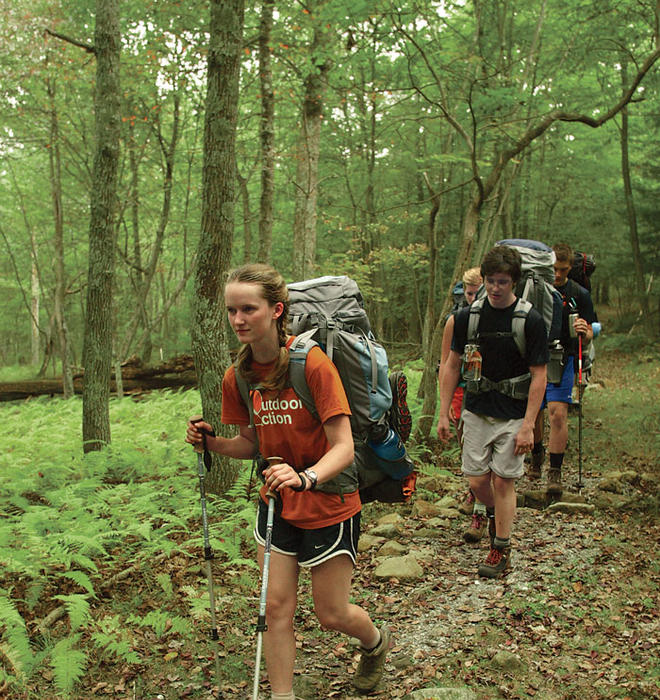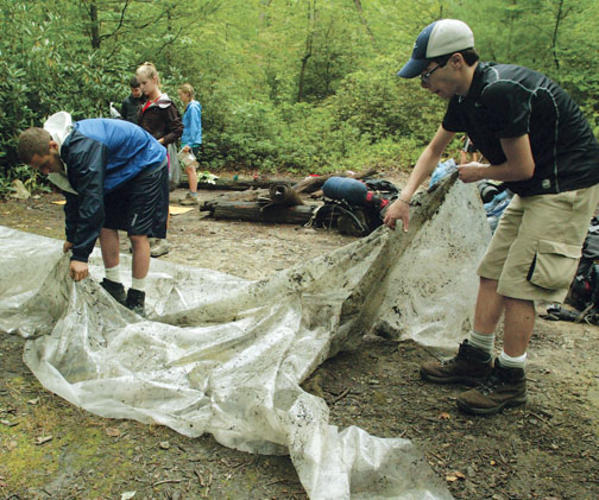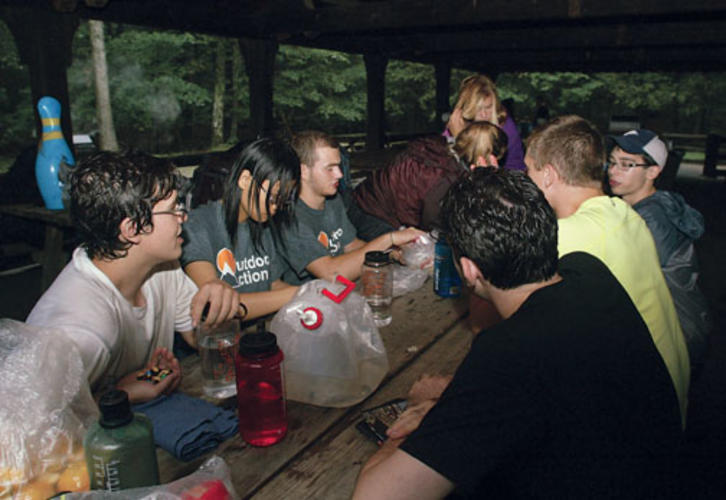
'Not ideal,' but bonding nonetheless
On Sept. 4, 790 freshmen and 233 undergraduate leaders embarked on what were planned as six-day backpacking and camping trips through Outdoor Action, Princeton’s popular outdoor-education program. PAW tagged along with one of the 97 groups — known as PA-64 — for two days.
(This is a corrected version of an article published in the Oct. 26, 2011, issue. The correction appears at the end of the story.)
It’s just after 9 p.m. on a Sunday, the first day hiking on the Appalachian Trail in central Pennsylvania, and Outdoor Action leaders Amy Ousterhout ’13 and Cody Kitchen ’14 are listening to a round of “rose, bud, thorn,” a classic debriefing exercise for outdoor-education programs. The trip’s eight freshmen, illuminated by the bluish glow of a headlamp strapped to a plastic water bottle hanging above, take turns sharing three things from the day’s hike: a memorable moment (the rose), something to look forward to (the bud), and a negative experience (the thorn).
With only a few hours on the trail, the roses and thorns are fairly pedestrian. The buds provide more colorful answers. Aron Wander ’15, for example, looks forward to Tuesday, when the group will have a chance to swim in a nearby lake, the closest thing they’ll have to a shower this week.
Before Ousterhout completes the session, soft flashes of lightning in the distance remind her that this would be a good time to review Outdoor Action’s lightning protocol, which involves splitting into two groups and crouching in a somewhat uncomfortable position — knees apart, arms folded close to the body. Within 15 minutes, the approaching storm forces the group to put this new knowledge into action.
Ousterhout and Kitchen each take half of the students to a divided wooden shelter about 200 yards up the trail from the group campsite, where they’ve pitched a tarp. As the rain moves from steady to torrential, the freshmen dutifully crouch and tuck, passing the time by pointing and tapping their way through another campsite game.
The group heads back down the trail when the rain slows, flashlights in hand, navigating slippery rocks and small log bridges. The tarp tent has done its job, but the tarp flooring has not, allowing puddles of muddy water to collect between the group’s sleeping bags.
“New OA protocol,” Kitchen calls out with a smile. “When you have a shelter, use it.”
Back up the trail they go, damp sleeping bags bunched in their arms. Two more rounds of rain and lightning follow — including one that sweeps through just as the group leaves the shelter to dig some dry clothing out of their packs — but finally, a half-hour after midnight, the rain slows to a drizzle. The campers go to sleep, shoulder to shoulder on the wooden planks.
The freshmen of PA-64 met Saturday at a raucous “pump-up” rally in Dillon Gym.
Their hometowns stretch from Potsdam, N.Y, to Wuxi, China. There are math whizzes, varsity athletes, and aspiring policy wonks. At the start, they are strangers. By week’s end, they’ll be a cohesive group, bonded by shared experiences. That’s the goal, at least.
Outdoor Action leaders work with a variety of tools to build a sense of purpose and unity, including camping lessons and an endless array of icebreaker games. But on this trip, the most useful tool is a relentlessly positive outlook. When faced with negatives, Ousterhout and Kitchen rely on the subtle, euphemistic refrain “not ideal.” Opening a trip with a wet tarp is not ideal. The three rounds of lightning protocol were not ideal. Five hours of sleep? Not ideal. But you wake up in the morning, cook breakfast, and get back on the trail.
That seems to be the itinerary for Monday, and by lunchtime, the group’s spirits are as high as they had been when they stepped off the bus from campus a day earlier. Eating a lunch of tortillas filled with peanut butter or tuna (and in some cases both), the students nearly forget the long night.
But a few yards down the trail, Ousterhout and Kitchen receive news of another “not ideal” situation in the works. On their OA-issued satellite phone, they read an emergency text message informing them of heavy rains approaching — three to six inches expected in the next two days — and they call the campus-based support center to arrange evacuation plans.
The next 24 hours are filled with bad luck. The group’s low-lying campsite proves unfit for camping, so the students are shuttled to another, well after dark. They hike for 45 minutes, guided by flashlights and headlamps, taking a wrong turn into a streambed. (In heavy rain, trails and streams often look alike.) When they finally reach the next site, they find another OA group already settled in the wooden shelters, so PA-64 sets up its nearly dry tarp at about 11 p.m. The students hang food in bear bags after midnight, get a few hours of sleep, eat breakfast, and then hike back to the road to be evacuated.
Half of the group leaves in a shuttle van Tuesday morning, expecting that the worst is over. But as the others begin to board their van, the campers hear a loud crack and see a tree trunk falling toward them.
Just before the tree shatters the van’s rear window, Jeff Kessler ’15 pulls a student shuttle driver away from the falling trunk.
A branch hits Wander on the back, and Kitchen, who is sitting inside the van, immediately thinks the vehicle has been struck by lightning. But no one from PA-64 or the other Princeton group waiting at the same site is seriously injured.
Within minutes, the freshmen are joking about their brush with death. When they eventually rejoin their trip-mates — emerging from state police cars and brushing the glass from their backpacks — they tell the story with an enthusiasm that Kitchen says is emblematic of an endearing group trait: “looking at the absurdity of our situation and laughing at it.”
For two days, while the freshmen wait for a bus back to Princeton, Kitchen and Ousterhout lead activities at a hotel in nearby Gettysburg, Pa. The surroundings are more comfortable than a tarp tent, but there still is room for bonding. The group even makes use of its trail food, cooking a Wednesday-night meal of bulgur wheat with peanut sauce on camp stoves in a parking garage next to the hotel.
“They were trying so hard to continue the outdoor experience,” Olivia Howard ’15 says of Kitchen and Ousterhout. “I’m glad they didn’t give up.”
OA trips are accustomed to a few logistical headaches, but this year, it was more like a 12-day migraine, stretching from the day that Hurricane Irene hit the Northeast to the day that the last of the groups returned to campus. Irene forced OA director Rick Curtis ’79 and his staff to reroute nearly half of the trips from parks that either had been closed or were inaccessible by bus. Then, after less than two days on the trail, rain from Tropical Storm Lee forced all of the trips to hotels and then back to campus. The mass evacuation was unprecedented, according to Curtis, who has led OA for the last three decades. With such short notice, the arrangements for busing students back to Princeton were not ideal, as participants would say. But through it all, Curtis says, the year’s trips displayed OA leadership “at its best.” Leaders “had to be much more focused on safety and group morale” than they would have been on a typical trip, he says.
Curtis believes that the OA frosh trips accomplished their mission, despite taking a circuitous route. One selling point for the trips is that they ease the transition to college. Freshmen return with a better understanding of Princeton, thanks to frank conversations with their leaders and peers, and they gain a small circle of friends. A week after returning to campus, that seemed to have succeeded. Most of the students in PA-64 had spent time together at meals or in their dorm rooms, and some had become close friends.
The week’s low point was not what you might expect, Kessler says: “It wasn’t the tree falling or setting up camp at 11 p.m. in the rain. The low point was definitely finding out that the trip was canceled.”
Ousterhout and Kitchen know that curtailing the trip meant freshmen missed key experiences. They worry that without those experiences, this freshman class will be less interested in signing up to be leaders. Curtis says he’ll know how many hope to become leaders soon, when OA begins scheduling its six-day training trips.
Wet tarps and broken windows have not tamped the enthusiasm of this year’s leaders. When asked whether they’ll do it again next year, Ousterhout and Kitchen didn’t hesitate, answering almost in unison.
“Of course.”
“For sure.”
For the record
The number of student leaders was originally misstated in the opening paragraph. There were 233 trip leaders this year.











1 Response
Roger Singer ’93
9 Years AgoBonding and risk on OA trips
The article on Outdoor Action (feature, Oct. 26) reminded me of my experience. Yes, I met fellow students and bonded with them (including one who became one of my best Princeton friends). But we also had other things in common with this year’s trips: We were lost (wandering into a Rutgers insect-research site, sleeping in the wrong place), disaster struck for which we were not prepared, and we were evacuated after a delay. Let us not forget that Austin Nahm ’93 was killed while, at the direction of OA, we crossed a busy road at dusk. One of my OA bonding moments came at a grief-counseling session. It seems that Outdoor Action remains a laudable idea, executed at a persistently underestimated level of risk.